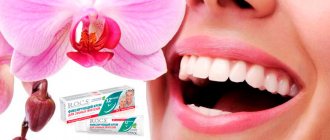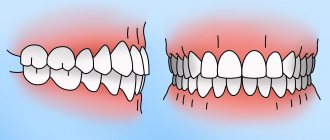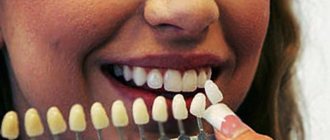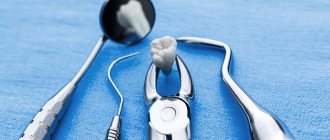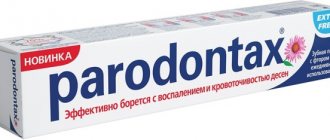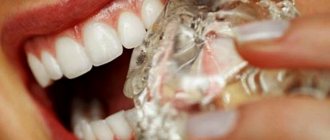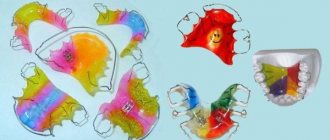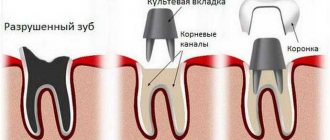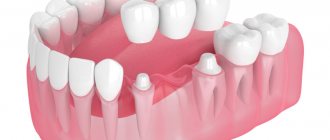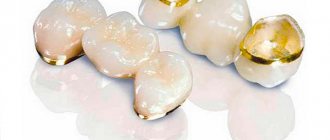Dentists work in different directions - you probably noticed in our price list and website materials such words as “orthodontist”, “surgeon”, “orthopedist”, “hygienist”. All of these are separate specializations of dentists. Each doctor specializes in a specific area of diagnosis and treatment. Usually it all starts with a consultation with a therapist, who, if necessary, refers the patient to a specialist doctor. In fact, you do not need to know in detail what an orthodontist does. If you are concerned about the condition of your teeth or oral cavity, simply schedule a consultation with us. After the examination, the therapist will outline the problem and a plan for further action.
Everything that concerns the bite and position of the teeth, the restoration of an even dentition is orthodontic treatment. This means it is clear what an orthodontist does and who he is in dentistry. That's right - this is the doctor who installs braces and aligners, helps children and adults achieve a beautiful smile with the help of special designs.
What diseases does an orthodontist treat?
Now it is clear what diseases an orthodontist treats. In dentistry, uneven teeth and abnormal bites are problems that most often cause imbalance of the jaw bones, affect the formation of facial features, diction and much more.
Now it is fashionable to treat such orthodontic diseases. There is no longer any shame in wearing braces. This is even a trend among young people - locks on teeth can be colored, transparent or the same shade as the enamel. You can smile and take pictures with braces. And after completing treatment in 1-3 years, you will get the smile of your dreams that will last a lifetime.
Orthodontists in Krasnoyarsk accept not only children and adolescents, but also adult patients. Obviously, an adult’s teeth have long been firmly fixed in their position and it is quite difficult to change this. Unlike children's molars, which erupted just a few years ago and can be easily corrected. However, bite correction is also possible for adults! Most often, orthodontic treatment takes 2–3 years, and the result pleases the patient and remains with him forever.
Prosthetic methods
Let's consider all the methods of installing prostheses and implants known to modern orthopedics.
Microprosthetics
The method is indicated when it is inappropriate to install a filling on a crumbled molar: if the tooth walls are severely damaged, but the root is intact. To save the unit from further deterioration, lumineers or veneers are installed. These are dental onlays made of ceramic or other dental material.
In orthopedics, dental inlays and dental onlays are used. An onlay is a plate that is fixed to the tooth enamel of the front part of the crown. Inlays cover the dental canals. They are used to restore chewing lateral molars.
Microprosthetics has no analogues; it is the fastest and most gentle way to restore the integrity of teeth.
How are veneers different from lumineers? To install veneers, grinding is required; lumineers are fixed to the front part of the teeth walls without preliminary grinding of the enamel coating. They are much thinner than veneers. The disadvantages of veneers include the impossibility of installing another type of prosthesis after removal: only the same ones. This is due to the grinding of the enamel layer during installation. Turning is necessary due to the thick layer of veneer plates.
To fix lumineers, turning is not necessary, because the thickness of the plates does not exceed 0.03 mm. But lumineers do not hide all aesthetic imperfections. For example, they do not mask chips in the enamel, unlike veneers.
Removable dentures
Removable dentures are available to everyone due to low prices, and discounts are provided for pensioners. The disadvantage is that turning healthy units is a painful and tedious procedure. Next, the doctor makes a plaster cast and sends it to the laboratory, where a technician models the removable structure.
Removable dentures differ in design features, price, fastening method, and material. These structures provide a solid base to which artificial dental crowns are fixed. In edentulous cases, removable dentures are secured with dental glue. If molars are partially lost, they are fixed to the remaining units in the jaw.
Methods of attaching prostheses:
- staples-clasps;
- locks (attachments);
- pilots;
- telescopic devices.
Clasps are iron brackets that cover the supporting units and securely fix the structure in the oral cavity. They are made in the shape of a semi-arc. The butterfly prosthesis is secured using clasps. This is an orthopedic design whose shape resembles the wings of a butterfly.
Plate dentures are a plate-shaped base to which artificial crowns are attached. This design is easy to put on and take off, and is easy to care for—no need to stick it to the gum.
Removable plates are installed for children who have lost their baby teeth. They help keep your teeth straight.
Clasp prosthetics are used when the patient cannot pay for implantation, and fixed structures cannot be installed. Clasp dentures are an arch on supports on which artificial crowns and acrylic gums are installed. The advantage of this design is the absence of surgical intervention to increase bone mass or the use of a flap technique for restoring the gum edge, as well as an open palate.
However, there are also quite a few disadvantages:
- it takes time for the jaw to adapt to a foreign object;
- daily care of the prosthesis is required;
- the patient cannot remove the prosthesis on his own;
- bone mass continues to decrease due to inadequate chewing load.
Due to subsidence of the bone mass, it is often necessary to replace the old prosthesis with a new one with different parameters.
The best option for the loss of several molars is implantation. Thanks to it, not only the integrity of the dentition is restored, but the patient’s health is also maintained. A full chewing load ensures blood flow to the tissues, and the loss of bone mass stops.
Fixed
Fixed orthopedic structures include bridges and crowns. They are securely fixed in the jaw and can only be removed by a doctor. Single implants are attached to titanium pins implanted into the gums, which replace the tooth root. On top of them are placed artificial imitations of teeth - crowns. If the molar is only partially destroyed, then it is covered with an artificial crown for strengthening and aesthetics.
Metal-ceramic crowns
Crowns are made from various materials - from medical plastic to gold plating. Recently, hypoallergenic crowns made of metal ceramics, which imitate a natural molar, have become widespread. Ceramics reliably protects the mucous membrane from contact with metal alloys, is easy to clean, and does not stain the color of food. Disadvantage: Some metal alloys can cause inflammation in the gum tissue.
Zirconium dioxide crowns
Unlike analogues, zirconium dioxide is not oxidized by saliva. Accordingly, in the absence of oxidative reactions, inflammatory processes in the soft tissues of the gums do not begin. When modeling crowns, computer technology is used, which allows you to create sizes and shapes that are as close to natural as possible. Also, models made of zirconium dioxide have a greater choice of colors: this allows you to choose a tone that will not stand out among the dentition.
Solid ceramic
They are installed on the front part of the dentition; they are completely free of metal components. They cannot be installed on chewing molars: they will not withstand the load.
Implants
Unlike crowns and bridges, they are implanted into bone tissue with subsequent fusion. They look like metal screws and are made from special metal alloys. Implants completely replace lost roots; artificial crowns are attached to them.
Bridges
Installed in case of loss of several adjacent molars. The structure with artificial crowns is attached at the edges to supporting units or implants replacing them. Some designs may consist of five artificial teeth.
Types of bridges:
- metal;
- metal-ceramic;
- plastic;
- metal-plastic.
Metal
They are not used in modern orthopedics, although they used to be widespread. Metal bridges are reliable, durable, and inexpensive. But there is a significant drawback: they are heavy, bulky, and can cause an allergy to metal.
Metal-ceramic
Metal-ceramic bridges are also reliable and durable; they have an advantage over metal ones - ceramic lining. But often the metal base is visible through the ceramics, so such bridges are not installed on the front part.
Plastic bridges
Used as a temporary structure to replace the main installation. For example, they are used while waiting for the manufacture of a metal-ceramic bridge.
Plastic quickly absorbs dyes, so plastic bridges and crowns look unaesthetic.
Metal-plastic
More reliable than plastic ones. However, their service life is short - no more than two years. Then the structure needs to be replaced with a new one. With careful use, metal-plastic can last 5 years, but more often bridges fail much earlier.
According to the manufacturing method, bridges are divided into:
- stamped;
- adhesive;
- solid cast.
An adhesive bridge is used to fix one artificial molar. But it is not reliable because it cannot withstand the chewing load. Stamped products are a monolith of soldered crowns; such blanks are called soldered bridges. These models are already a thing of the past. Stamping has been replaced by more reliable casting methods.
The installation of bridges has a list of contraindications, including:
- bruxism (night teeth grinding);
- abnormal bite;
- periodontal diseases;
- pathological condition of bone tissue;
- lack of regular oral hygiene;
- lack of supporting elements or their poor condition.
Bridges are a good alternative to implants, but they have a significant drawback - preliminary grinding of healthy supporting units. They also do not solve the problem of bone tissue atrophy, which inevitably begins to decrease due to the lack of full chewing load.
Orthopedic dentist or orthodontist - who do I need?
We always advise patients not to waste time studying the nuances of dentistry from materials on the Internet. To make an appointment at the Mira clinic, you don’t need to know anything - just call us, describe your problem and choose a consultation time. It is always better to talk to a specialist in person and find out all the information, receive individual recommendations and treatment.
Understanding whether you need a prosthodontist or an orthodontist is quite simple. An orthodontist deals with bite and tooth position, an orthopedist deals with prosthetics and implantation. Don't worry about us scheduling you with the wrong doctor. Our clinic team takes a comprehensive approach to each patient. Even if you made an appointment with an orthopedist instead of an orthodontist, we will redirect you to the right specialist.
How is a dentist different from a dentist?
The difference is in the level of education and credentials. According to the job description, the dentist cannot perform certain types of treatment.
In practice, patients often encounter specialists without higher education, “jacks of all trades.” This situation is common in small settlements, where a medical institution has only one staff member for the treatment of oral diseases.
Take note:
- many specialists with secondary medical education claim that they perform dental treatment no worse than dentists, supporting their arguments with reviews from satisfied patients;
- but without the necessary level of knowledge it is impossible to correctly deal with a complex case and prevent side effects;
- without constant professional development, the introduction of new technologies, and modern materials, it is impossible to offer the patient the most gentle method of treatment;
- It is no coincidence that private dental clinics regularly spend considerable sums on advanced training courses and symposiums for practicing doctors.
Consultation with an orthodontist
Not everyone can correct the position of their teeth - but if you dream of seeing a perfect smile in the mirror and do not want to deal with dental problems in old age, you need to consult an orthodontist.
Please note that an examination and conversation with a doctor does not obligate you to get braces. This is an informative consultation where you will learn about your characteristics, possible risks and the approximate course of treatment for crooked teeth. After this, you can calmly weigh everything and decide whether to start treatment.
If you find it difficult to decide to wear braces for a long time, come to us. A consultation with an orthodontist will give you a complete understanding of your situation: the doctor will tell you in detail which teeth need correction, how long you will need to wear braces, and which designs are right for you. You will also learn about the risks that are likely if you do not work with the bite and leave everything as it is.
A little bit of history
The first echoes of methods for correcting the position of teeth were found in the works of Hippocrates, dating back to 400 BC. Many years later, namely in 1728, Pierre Fauchard presented to the world a book called “The Dentist Surgeon,” in which an entire chapter was devoted exclusively to the problems of bite and crooked teeth. It was only in the 1850s that the first scientific works on orthodontics or orthodontia began to appear. Thus, one of the pioneers in this area was Norman Kinzley, known not only as a dentist, but also as a talented artist, writer and sculptor. It was he who first resorted to extraoral traction to treat dental protrusion. By 1880, Dr. Kinzley had published a book entitled A Treatise on Dental Anomalies.
The photo shows the first corrective devices
An important role in the formation and development of orthodontics was played by Dr. Farrar, who at one time published the book “Treatise on Disorders of Teeth and Their Correction.” He developed and presented to the world one of the first non-removable corrective devices, and also proposed to provide a gradual and uniform impact to correct the position of teeth with pauses during the treatment process.
In Russia, specialists in the field of orthodontics began to appear relatively recently, namely towards the end of the 20th century. And if in Soviet times an orthodontist was a doctor who treated anomalies of the jaw apparatus strictly according to indications, then after the collapse of the USSR orthodontic treatment increasingly began to be used for aesthetic purposes. To become an orthodontist, it is not enough to study at the dental faculty of a medical university. The young specialist must also successfully complete a residency in orthodontics, but we’ll talk more about this a little later. In the meantime, let's take a closer look at the question: “Dentist-orthodontist - who is he, what kind of doctor is he and what exactly does he do?”
Where do the best orthodontists in Krasnoyarsk work?
How to find your doctor and find out where the best orthodontists in Krasnoyarsk work? Most patients are introduced to different specialists and then choose from them. To solve the problem of bite, it is worth consulting with several orthodontists. And then choose the one who seems more competent, caring and attentive to you. It also matters what kind of braces and aligners the clinic works with. For example, in Mira dentistry, patients are offered a large selection of designs with different parameters: material, cost, treatment period, size.
Take your time when choosing a specialist who treats orthodontic diseases. Once you find the perfect doctor for you, your years in braces will fly by!
Bottom line
Orthopedics is a branch of medicine that deals with issues of the musculoskeletal system. Orthopedics in dentistry deals with the problem of restoring chewing and speech functions, returning the patient to the ability to fully chew food and talk with people. If any number of teeth are lost, the patient seeks help from a prosthetist. The choice of dentures depends on the financial capabilities of the patient, the clinical picture, and the equipment of the dental clinic.
The best option is to install implants with subsequent fusion with bone tissue. Such structures protect bone mass from atrophy and completely replace tooth roots. Removable and fixed dentures are cheaper than implants, but do not protect bone and gum tissue from atrophy and loss. The choice of prosthetic method also largely depends on the condition of the patient’s oral cavity: for many, bridges or other structures are contraindicated due to malocclusion, pathology of bone or gum tissue.
Sources used:
- Abolmasov, N. G. Orthopedic dentistry. - Moscow: MEDpress-inform, 2007.
- Lebedenko I. Yu., Kalivradzhiyana E. S. Orthopedic dentistry: textbook. — Moscow: GEOTAR-Media, 2012.
- Wikipedia article
Dentist-therapist
It all usually starts with this dentist. People come to him when they are worried about toothache or other symptoms associated with the maxillofacial area. He conducts diagnostics and an initial examination, establishes a diagnosis and prescribes treatment, and gives referrals to specialized specialists. His competence includes standard problems: caries, infectious diseases and inflammatory processes in the oral cavity.
Dentist-therapist:
- cleans channels;
- removes nerves;
- installs seals;
- removes tartar and plaque;
- restores teeth;
- performs sanitation of the oral cavity before prosthetics or other dental procedures.
How to choose the best orthopedist in Moscow?
What to do if you urgently need to find an orthopedic dentist in Moscow? Special services are successfully operating on the Internet, where ratings of the best orthopedic dentists are presented, based on reviews from grateful patients who have already used the services of these doctors. Here, any user can choose from the proposed list and make an appointment with an orthopedic dentist. Consultation is usually free. In some cases, a fee of 300-4500 rubles is provided for the provision of services.
0%
Installment plan without overpayments
Start treatment today!
Take advantage of interest-free installments for 2 years without a down payment
Find out more
8
Payment by installments is possible without bank participation
And here the question arises: how to choose the best orthopedic dentist? According to experts, when choosing the best orthopedic dentist, one should take into account his professional experience, level of qualifications, and customer reviews. Professional skills must be confirmed by appropriate certificates. The opinion of your relatives and friends who have already used the services of a particular orthopedic dentist also plays an important role.
Professional orthopedic dentists at the Partner-Med clinic work with unique methods of dental restoration and prosthetics that are recognized internationally. All specialists have the highest qualification categories, many years of experience and extensive experience in their field. We are pleased to offer gentle dental prosthetics from the best prosthetic dentists in Moscow, consultation with a gnathologist for complex dental prosthetics, an individual approach and a guarantee for the dental services provided. Trust the professionals!
Deputy Chief physician Sergey Evgenievich Brodsky
Sign up for a free consultation
+7
Just CALL US!
+7
We will answer any of your questions and will definitely help you!
Microdental prosthetics
Removable dentures
Removable dentures are inexpensive, easy to install, and easy to care for. These dentures come in several types: plate, clasp, suction cups, butterflies. Removable structures are most often used:
- with edentia - if there are missing teeth on one or both jaws;
- for elderly people - other types of prostheses are more expensive and may not be well tolerated by the elderly;
- for children - when early loss of baby teeth can cause crooked dentition.
- Fixed structures
Fixed dentures are durable and reliable, have an attractive appearance, and are made from different materials, which makes it possible to provide prosthetics to people with any financial capabilities. These include:
- crowns are prostheses that are placed in a wide variety of situations, but most of all they are suitable for frontal single molars;
- Bridges are an excellent solution when several teeth are missing in a row;
- dentures on implants - this design will last a lifetime, but it also costs accordingly.
- Fixed orthopedic structures
Based on the results of this article, we can conclude that an orthopedic dentist treats all types of tooth loss, up to their complete absence. Today, insufficient dentition is not a problem, because to solve it you just need to go to one of the many clinics where qualified prosthetists work.
This is interesting
Did you know that dentists and dentists have a professional holiday? And not just one, but several!
Congratulate your beloved doctor:
- February 9th. International Dentist Day.
- March, 6. International Dentist Day.
- April 24. Russian Dentist Day.
- July 25. Dental Technician Day.
- 12-th of September. World Oral Health Day.
Now you know the difference between a dentist and a dentist. If your teeth are in poor condition or have complex cases of dental disease, do not refuse to consult a specialist. Only a professional will perform prosthetics, bite correction or complex tooth extraction.
If it is difficult to find a qualified orthodontist or prosthetist in your town or village, contact a large center in another locality. Don’t trust your oral health to “generalists.”
Types of dentures
The choice of type of prosthetics depends on many factors. Here the role is played by the condition, number and location of the teeth, the individual characteristics of the patient, pricing policy and other circumstances. The difference in what the orthopedic dentist does in each individual case lies in the techniques used and the prostheses used.
Microprosthetics
Suitable for situations where you need to restore a deformed or damaged tooth. The following prostheses are used:
- Veneers. The doctor places them if there are minor defects in the front teeth: chips, cracks, curvature, discoloration. Veneers are thin ceramic plates up to 0.7 mm wide that completely follow the shape of the tooth, are installed in one appointment and last up to 10 years.
- Lumineers. They are placed when, for some reason, veneers are contraindicated for the patient. These pads are slightly different from each other. The difference is that lumineers are thinner (0.3 mm), more difficult to get used to, hide defects less, and are more prone to breakage.
- Tabs. They are very similar to fillings, but they also have some differences: they last longer, are made of durable ceramics, are able to recreate the shape of the tooth, and are also used when the filling is ineffective.
Dental surgeon
This doctor comes to the rescue if conventional treatments are ineffective and drastic solutions are needed that require surgical intervention.
Dental surgeon:
- removes teeth, tumors and cysts;
- eliminates acquired and congenital defects;
- opens foci of abscess and other inflammations;
- prepares the jaw for prosthetics and performs implantation;
- deals with restoration and plastic surgery of the jaw, as well as any other operations in the oral cavity.
Orthopedic dentistry
The main goal of prosthetic dentistry is to eliminate problems associated with the masticatory apparatus by installing special dentures, removable or fixed. In parallel, this medical industry solves the following problems:
- Prevention and diagnosis of speech apparatus anomalies.
- Treatment of jaw diseases using a variety of orthopedic structures.
- Maintaining the attractive appearance of restored teeth.
Thus, all efforts are aimed at eliminating any dental anomalies that can reduce the patient’s quality of life. Active work is underway to restore the aesthetics and full functions of the dental system.
